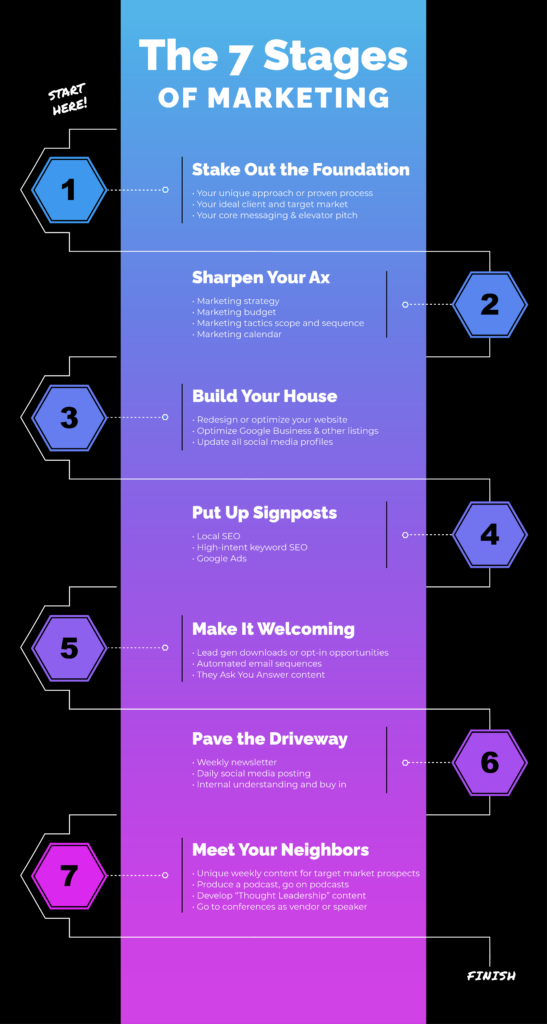The 7 Stages of MFAF: Creating a Marketing Budget for Accounting Firms

When you create a marketing plan for an accounting firm, you want to think about it like building a house. You need to follow a plan, keep it simple, and build it step by step. We believe that philosophy so much that Matt, our founder, helped codify it into seven steps for anyone to follow. Over the course of the next several weeks, we’ll be fleshing out some of the ideas listed in this infographic and how they can be applied to the marketing plan for your accounting firm.
Sharpening Your Axe: How to Create a Marketing Budget for Accounting Firms
There is a saying attributed to Abraham Lincoln that says “If I had 6 hours to chop down a tree, I’d spend the first 4 sharpening my ax.” While it sounds like Lincoln reeeeeeally thought about axes an awful lot, there’s still good advice here. When it comes to marketing, your ax is strategy. Strategy is the plan for what you’ll do, in what order, at what level in order to win.
There are four components to a durable strategy, plus one additional option. Let’s look at our checklist for this week.
- Strategy Statement
- Marketing Budget
- Comprehensive Tactics List
- 12-month Marketing Calendar
- Optional: 1-Page Marketing Plan
Strategy Statement
This statement describes the big-picture things that must become true in order for you to achieve your goals, along with the general approach you will take to make those things happen.
Examples:
- We will be known and widely recognized in our local community as the best accounting and advisory firm to help small businesses grow their profitability. We will be easy to find online, will develop relationships with local bankers/lenders/brokers as referral sources, and make sure our name/logo is seen by any potential clients within 10 miles of our office.
- We will be seen as the business and accounting experts for lawyers in California. We will build a network and email list of lawyers, develop relationships with vendors and influencers for referrals, and become integrated with lawyer groups and associations in California.
Marketing Budget
Most firms operate without a marketing budget. Instead, they make decisions on the fly about what to do and how to spend. Reactive marketing is not effective marketing. Proactive marketing requires planning.
You should have a marketing budget that is between 2%-7% of your total revenue (sales and marketing combined should be 5%-10%). Your budget should also include a “cost of acquisition” target (typically 15-25% of your average client value) that you can use to help judge the ROI on various marketing tactics.
Your budget should usually include all costs associated with marketing, including the salaries, commissions, or bonuses for in-house marketing people, software, ad spend, and any agency or other 3rd party fees.
Comprehensive Tactics List
There are hundreds of marketing things you could do, but you can’t do them all, so you will need to choose where to invest your time and money. It’s helpful to have a full list of the things you could be doing along with a general cost (time and money) associated with each tactic.
This will help you avoid chasing every new shiny marketing object that you come across, and commit to doing what is most important right now.
12-Month Marketing Calendar
Some things require a larger upfront investment; others have an ongoing fee attached. Developing a 12-month calendar helps you see what you’ll spend when and how that fits your overall budget. Your marketing calendar should include the tactics/campaigns you will be running each month, along with the cost associated with each one.
A calendar is flexible. You can adjust your tactics based on what is and isn’t working, and if your financial numbers change. But you should have a year planned out so you can see what your priorities are at all times.
Optional: 1-Page Marketing Plan
The 1-Page Marketing Plan was developed by Allan Dib (his book is a great introduction) and is a helpful way to think through all aspects of your marketing plan, from positioning to closing sales to increasing the lifetime value of a client.
A mistake that many marketers make is thinking their job ends once a lead lands on the website when in truth, much of the lowest-hanging fruit is through marketing to clients you already have. The 1-Page Marketing Plan template helps you identify opportunities at all stages of your client’s journey with you.
Next week: It’s time to start building your house
You’ve done the prep. Now it’s time to start building out your ‘house’ when it comes to marketing.


